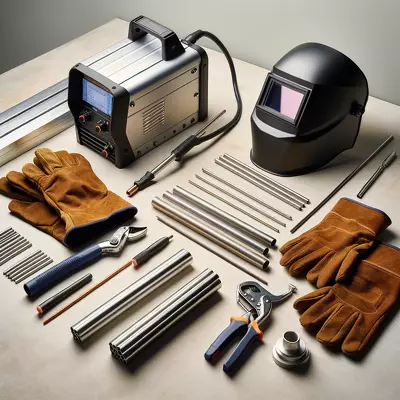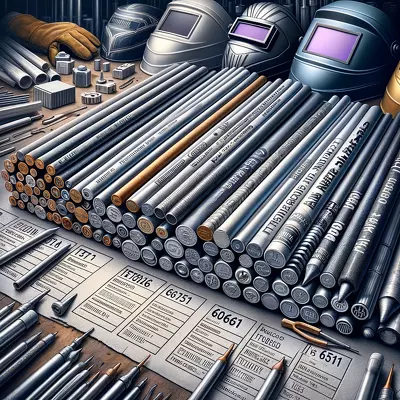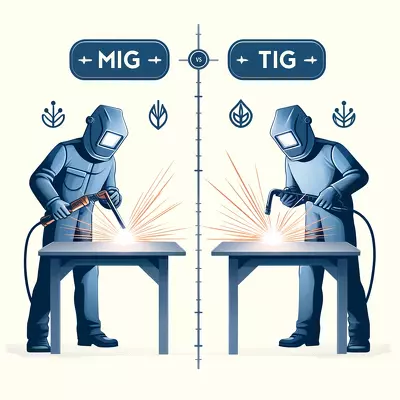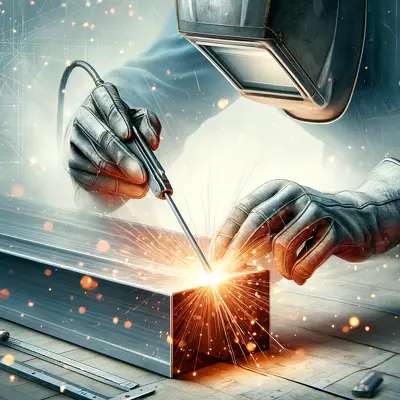The Beginner’s Blueprint to Mastering TIG Welding Aluminum: A Step-by-Step Guide

TIG welding aluminum presents a unique set of challenges and opportunities for beginners eager to master this valuable skill. Known for its precision and control, TIG (Tungsten Inert Gas) welding allows for high-quality joins in aluminum, a metal prized for its lightweight and strong properties. This guide aims to equip novices with the essential techniques and tips needed to start TIG welding aluminum effectively, emphasizing practical advice to overcome common hurdles.
I. Introduction to TIG Welding Aluminum
A. Understanding TIG Welding
Tungsten Inert Gas (TIG) welding, a method known for its precision and versatility, plays a crucial role in modern fabrication and repair. This technique utilizes a non-consumable tungsten electrode to produce the weld, while an inert gas, typically argon, shields the welding area from atmospheric contamination. This process is particularly advantageous when working with aluminum, a metal that requires careful handling due to its susceptibility to oxidation.
B. The Importance of Welding Aluminum
Aluminum, with its remarkable combination of strength, lightweight, and resistance to corrosion, is extensively used across various industries, including automotive, aerospace, and construction. The ability to join aluminum parts effectively and efficiently through TIG welding opens up vast possibilities for manufacturing and repair, making it an essential skill for professionals in the field.
C. Overview of TIG Welding for Beginners
For those new to the craft, TIG welding aluminum can seem daunting. However, with a solid understanding of the fundamentals, appropriate preparation, and practice, beginners can achieve high-quality welds. This guide aims to demystify the process, providing step-by-step instructions and tips to help novices navigate their TIG welding journey.
II. Preparing to TIG Weld Aluminum
A. Selecting the Right Equipment
- TIG Welder: Choosing a welder capable of AC (Alternating Current) is critical, as aluminum welding requires the AC setting to effectively clean the oxide layer on the material’s surface.
- Aluminum Welding Rods: Selecting the appropriate alloy and diameter of welding rods is crucial for compatibility and weld strength.
- Protective Gear: Safety equipment, including a welding helmet with proper shading, gloves, and protective clothing, is essential to safeguard against ultraviolet radiation and hot metal.
B. Setting Up the Workspace
- Ventilation and Safety: Ensuring adequate ventilation in the welding area is necessary to dissipate harmful gases. Additionally, keeping a fire extinguisher nearby is a prudent safety measure.
- Organizing Tools and Materials: A well-organized workspace with easy access to tools and materials enhances efficiency and safety.
C. Preparing the Aluminum
- Cleaning the Material: Removing any contaminants such as oil, dirt, or oxide layer from the aluminum surface is essential for a strong weld.
- Preheating Aluminum: Preheating the material to a suitable temperature can reduce the risk of warping and cracking, particularly for thicker sections.
III. The TIG Welding Process
A. The Basics of TIG Welding Technique
- Holding the Torch: A steady hand is required to maintain the optimal angle and distance from the workpiece.
- Controlling the Pedal: The foot pedal controls the heat input during welding, requiring practice to master the coordination for smooth welds.
B. Welding Aluminum
- Starting the Arc: Initiating the arc without contaminating the tungsten electrode demands skill and concentration.
- Filler Rod Application: Adding filler material at the right speed and angle is vital for achieving a uniform and strong weld.
- Managing Heat Distribution: Proper heat management prevents warping and ensures penetration without burning through the material.
C. Troubleshooting Common Problems
- Cracking: Often caused by contamination or incorrect alloy selection, cracking can be minimized with a thorough cleaning and appropriate material choice.
- Porosity: Trapped gases lead to porous welds, which can be avoided by ensuring a clean base and filler materials.
- Warping: Controlled heat application and preheating can help in reducing warping in aluminum welds.
IV. After Welding: Cleaning and Inspection
A. Cleaning the Weld
Removing the oxide layer and any welding residue is essential for inspecting the weld quality and for subsequent finishing processes.
B. Inspecting the Weld for Quality
Examining the weld visually and, if necessary, with non-destructive testing methods ensures the weld meets the required standards and specifications.
V. FAQs
Q: What type of gas is best for TIG welding aluminum?
A: Pure argon is typically recommended for TIG welding aluminum due to its ability to provide a clean, stable arc.
Q: How thick can aluminum be TIG welded?
A: TIG welding is suitable for aluminum thicknesses from very thin sheets up to about 3/8 inch. Preheating or multi-pass techniques may be required for thicker sections.
Q: Can I TIG weld without using filler material?
A: While some thin materials and specific applications may allow for fusion welding without filler, using filler material is generally recommended for aluminum to ensure weld integrity.
Q: What is the best way to practice TIG welding aluminum?
A: Practice on scrap pieces of aluminum to get comfortable with controlling the torch and pedal, and experiment with different angles and speeds.
Q: Why does my weld look dirty or contaminated?
A: Contamination can occur from insufficient cleaning of the base material or using incorrect or contaminated filler material. Ensure all materials are clean and appropriate for the job.
Q: How do I prevent the tungsten electrode from contaminating the weld?
A: Maintain a proper torch angle and avoid touching the filler rod or the workpiece with the tungsten. If contamination occurs, re-grind the tungsten electrode.
Q: What settings should I use for TIG welding steel?
A: When TIG welding steel, switch the welder to DCEN (Direct Current Electrode Negative) and use a pure argon gas. The amperage setting will depend on the thickness of the steel.
Q: Can you use the Vulcan ProTIG 165 for welding aluminum?
A: Yes, the Vulcan ProTIG 165 is capable of welding aluminum as it offers both AC and DC output options suitable for aluminum welding.
VI. Conclusion
A. Recap of Key Points
This guide has walked through the essential steps and considerations for beginners looking to master TIG welding aluminum. From selecting the right equipment and preparing the material to executing the welding process and troubleshooting common issues, the aim is to provide a foundation upon which to build and refine welding skills.
B. Encouragement for Continuous Learning
The journey to becoming proficient in TIG welding aluminum is one of continuous learning and practice. The complexity of the process and the nuances of working with aluminum demand patience and persistence. By embracing challenges and remaining committed to improvement, beginners can develop into skilled welders capable of producing high-quality work.
VII. Suggested Readings
To further enhance your knowledge and skills in TIG welding aluminum, consider exploring these comprehensive resources:
- “Welding For Dummies” by Steven Robert Farnsworth: A beginner-friendly guide that covers various welding techniques, including TIG welding, offering practical advice and step-by-step instructions.
- “The Welding Business Owner’s Hand Book” by David Zielinski: Focuses on the entrepreneurial aspect of welding, including tips on TIG welding aluminum, which can be particularly useful for those looking to start their own welding business.
- “TIG Welding Secrets: An In-Depth Look at Making Aesthetically Pleasing TIG Welds” by Andrew Pearce: Provides advanced tips and techniques for perfecting TIG welds, with a focus on aluminum welding.
- “The Procedure Handbook of Arc Welding” by Lincoln Electric: Although not solely focused on TIG welding, this handbook offers valuable insights into the technical aspects of welding, including aluminum welding.
Exploring these books will offer a deeper understanding of the welding process and provide additional techniques and tips to enhance your welding skills. As you continue your journey in TIG welding, remember that each weld is a step toward mastering the craft. The learning process is ongoing, and with each challenge overcome, you’ll find yourself becoming more proficient and confident in your abilities.






